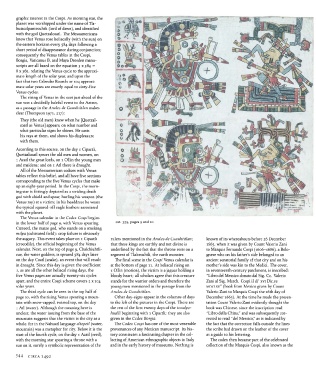Page 545 - Art In The Age Of Exploration (Great Section on Chinese Art Ming Dynasty)
P. 545
graphic interest in the Cospi. As morning star, the
planet was worshipped under the name of Tla-
huizcalpantecuhtli (lord of dawn), and identified
with the god Quetzalcoatl. The Mesoamericans
knew that Venus rose heliacally (with the sun) on
the eastern horizon every 584 days following a
short period of disappearance during conjunction;
consequently the Venus tables in the Cospi,
Borgia, Vaticanus B, and Maya Dresden manu-
scripts are all based on the equation 5 x 584 =
8 x 365, relating the Venus cycle to the approxi-
mate length of the solar year, and upon the
fact that two Calendar Rounds or 104 approxi-
mate solar years are exactly equal to sixty-five
Venus cycles.
The rising of Venus in the east just ahead of the
sun was a decidedly baleful event to the Aztecs,
as a passage in the Anales de Cuauhtitlan makes
clear (Thompson 1971, 217):
They (the old men) knew when he [Quetzal-
coatl as Venus] appears, on what number and
what particular signs he shines. He casts
his rays at them, and shows his displeasure
with them.
According to this source, on the day i Cipactli,
Quetzalcoatl spears the old men and women, on
i Acatl the great lords, on i Ollin the young men
and maidens; and on i Atl there is drought.
All of the Mesoamerican codices with Venus
tables reflect this belief, and all have five sections
corresponding to the five Venus cycles that make
up an eight-year period. In the Cospi, the morn-
ing star is fittingly depicted as a striding death
god with shield and spear, hurling his weapon (the
Venus ray) at a victim; in his headdress he wears
the typical squared-off eagle feathers associated
with the planet.
The Venus calendar in the Codex Cospi begins
in the lower half of page 9, with Venus spearing cat. 359, pages 9 and 10
Cinteotl, the maize god, who stands on a smoking
milpa (cultivated field): crop failure is obviously
the augury. This event takes place on i Cipactli rulers mentioned in the Anales de Cuauhtitlan; known of its whereabouts before 26 December
(crocodile), the official beginning of the Venus that these kings are earthly and not divine is 1665, when it was given by Count Valerio Zani
calendar. Next, on the top of page 9, Chalchiuhtli- underlined by the fact that the throne rests on a to Marquis Fernando Cospi (1606-1686), a Bolo-
cue, the water goddess, is speared 584 days later segment of Tlaltecuhtli, the earth monster. gnese who on his father's side belonged to an
on the day Coatl (snake), an event that will result The final scene in the Cospi Venus calendar is ancient senatorial family of that city and on his
in drought. Since this day is given the coefficient at the bottom of page 11. At heliacal rising on mother's side was kin to the Medici. The cover,
i, as are all the other heliacal rising days, the i Ollin (motion), the victim is a jaguar holding a in seventeenth-century parchment, is inscribed:
five Venus pages are actually twenty-six cycles bloody heart; all scholars agree that this creature "Libro del Messico donato dal Sig. Co. Valerio
apart, and the entire Cospi scheme covers 2 x 104 stands for the warrior orders and therefore the Zani al Sig. March. Cospi il di' xvi Die. re
solar years. young men mentioned in the passage from the MDCLXV" (book from Mexico given by Count
The third cycle can be seen in the top half of Anales de Cuauhtitlan. Valerio Zani to Marquis Cospi the i6th day of
page 10, with the rising Venus spearing a moun- Other day-signs appear in the columns of days December 1665). At the time he made the presen-
tain with snow-capped, twisted top, on the day to the left of the pictures in the Cospi. These are tation Count Valerio Zani evidently thought the
i Atl (water). Although the meaning here is the rest of the first twenty days of the tonalpo- book was Chinese, since the inscription read
unclear, the water issuing from the base of the hualli beginning with i Cipactli; they are also "Libro della China/' and was subsequently cor-
mountain suggests that the victim is the city as a given in the Codex Borgia. rected to read "del Messico," as is indicated by
whole, for in the Nahuatl language altepetl (water, The Codex Cospi has one of the most venerable the fact that the correction falls outside the lines
mountain) was a metaphor for city. Below it is the provenances of any Mexican manuscript. Its his- the scribe had drawn on the leather of the cover
start of the fourth cycle, on the day i Acatl (reed), tory constitutes a fascinating chapter in the col- as a guide to his lettering.
with the morning star spearing a throne with a lecting of American ethnographic objects in Italy The codex then became part of the celebrated
sun on it, surely a symbolic representation of the and in the early history of museums. Nothing is collection of the Marquis Cospi, also known as the
544 CIRCA 1492

